14-4 Galaxies are found in clusters and superclusters
Galaxies are not scattered randomly throughout the universe but are found in clusters. Figure 14-14 shows one such cluster. Like stars within a star cluster, the members of a cluster of galaxies are in continual motion around one another.
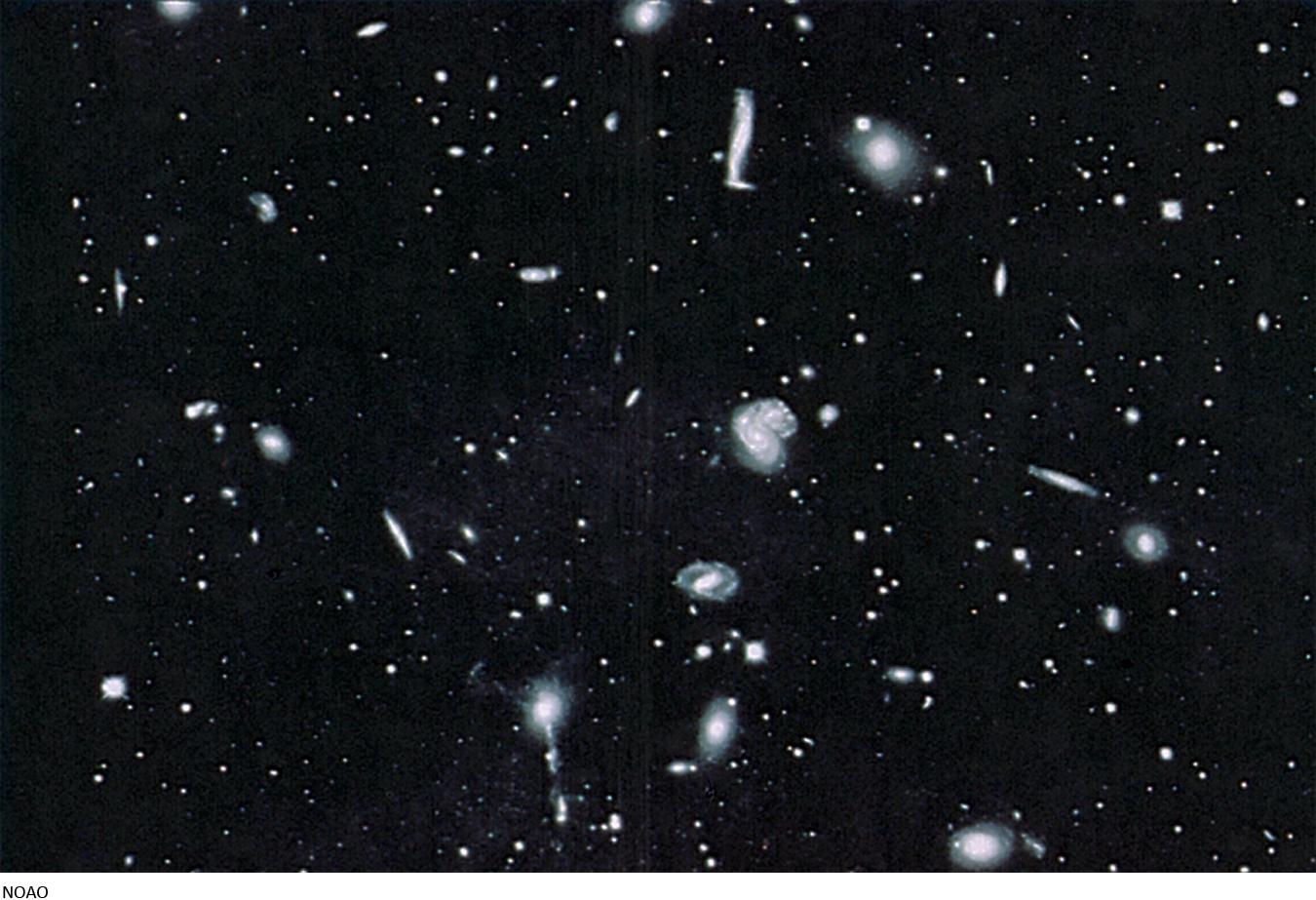
Clusters of Galaxies: Regular and Irregular
 Go to Video 14-3
Go to Video 14-3
Galaxies tend to be gravitationally bound into groups. For example, the Milky Way Galaxy, the Andromeda Galaxy (M31), and the Large and Small Magellanic Clouds of our neighborhood are part of a cluster called the Local Group. The Local Group contains more than 54 galaxies, most of which are quite small. Figure 14-15 is a map of a portion of the Local Group.
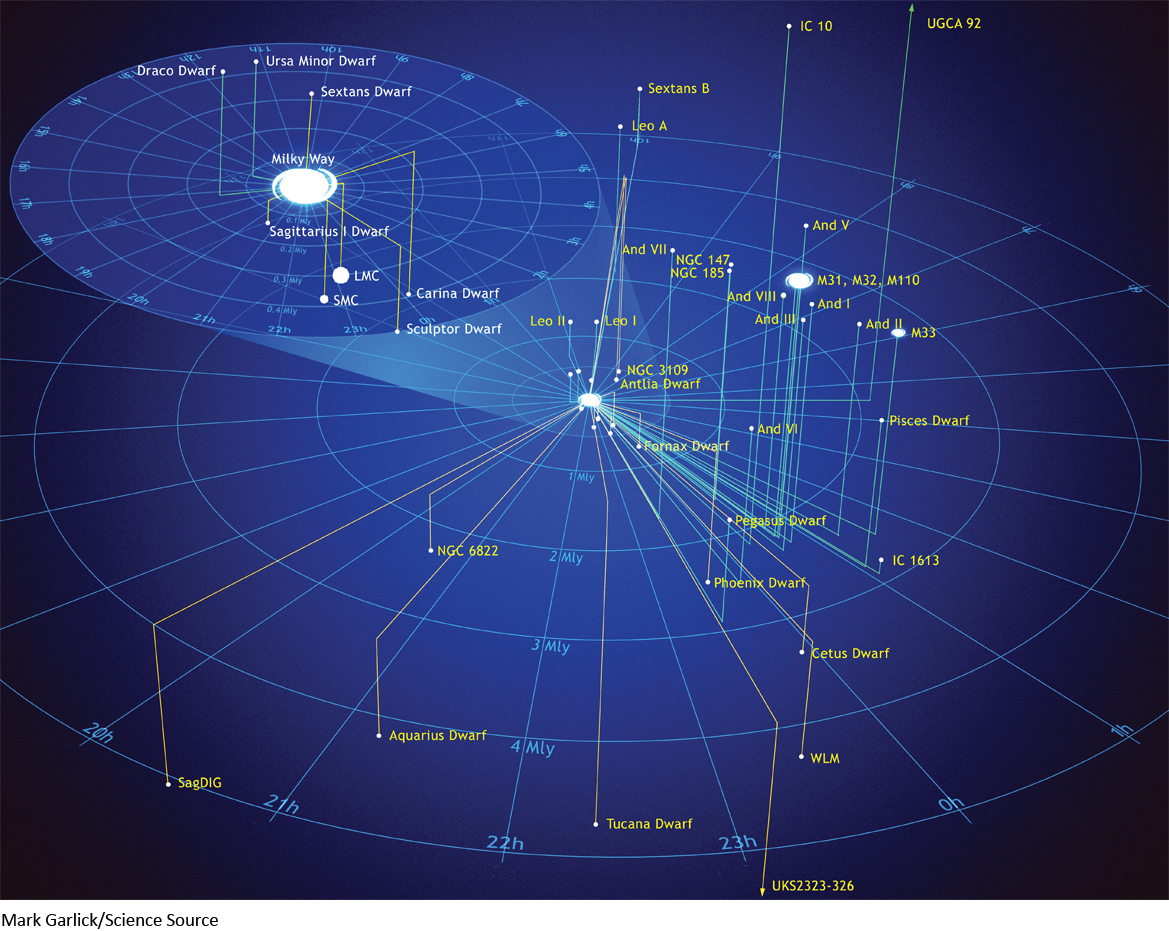
In recent years, astronomers have discovered several smaller, and previously unknown, galaxies in the Local Group. As of 2014, the nearest and most recently discovered is the Canis Major Dwarf, so named for the constellation in whose direction it lies as seen from Earth. It is about 42,000 ly from the center of the Milky Way Galaxy and a mere 25,000 ly from Earth (about the same as the distance from Earth to the center of the Milky Way). Tidal forces exerted by the Milky Way on the Canis Major Dwarf are causing this dwarf galaxy to gradually disintegrate and leave a trail of debris behind it (Figure 14-16).

We may never know the total number of galaxies in our Local Group, because dust in the plane of the Milky Way obscures our view over a considerable region of the sky. Nevertheless, we can be certain that no additional large spiral galaxies are hidden by the Milky Way because at least some of their light would not be completely absorbed by interstellar dust.
338
The nearest fairly rich cluster is the Virgo cluster, a collection of more than 2000 galaxies covering a 10° × 12° area of the sky. Figure 14-8 shows a portion of this cluster. One member of this cluster not shown in Figure 14-8 is the spiral galaxy M100; measurements of Cepheid variables in M100 (see Figure 14-3) give a distance of about 56 million ly. The Tully-Fisher relation and observations of Type Ia supernovae (see Figure 14-12) give similar distances to this cluster. The overall diameter of the cluster is about 9 million ly.
The center of the Virgo cluster is dominated by three giant galaxies. You can see two of these, M84 and M86, in Figure 14-8. The diameter of each of these enormous galaxies is comparable to the distance between the Milky Way and M31. In other words, one giant galaxy is approximately the same size as the entire Local Group!
Galaxies are clumped together in gravitationally connected groups, with vast empty spaces between galaxy clusters.
Astronomers categorize clusters of galaxies as regular or irregular, depending on the overall shape of the cluster. The Virgo cluster, for example, is called an irregular cluster, because its galaxies are scattered throughout a sprawling region of the sky. Our own Local Group is also an irregular cluster. In contrast, a regular cluster has a distinctly spherical appearance, with a marked concentration of galaxies at its center.
The nearest example of a regular cluster is the Coma cluster, located about 300 million ly from us toward the constellation Coma Berenices (Berenice’s Hair) (Figure 14-17). Despite its great distance, telescopic images of this cluster show more than 1000 galaxies, many of which are faint, dwarf galaxies. The Coma cluster is dominated by two large elliptical galaxies, but it almost certainly contains many thousands of tiny galaxies as yet unseen, and the total membership of the cluster may be as many as 10,000 galaxies. The overall shape of a cluster is related to the dominant types of galaxies it contains. Regular clusters contain galaxies that lack an apparent spiral structure. For example, about 80% of the brightest galaxies in the Coma cluster (see Figure 14-17) are of this type. Alternatively, irregular clusters, such as the Virgo cluster and the Hercules cluster shown in Figure 14-14, have a more even mixture of galaxy types, some with spiral structures and others without.
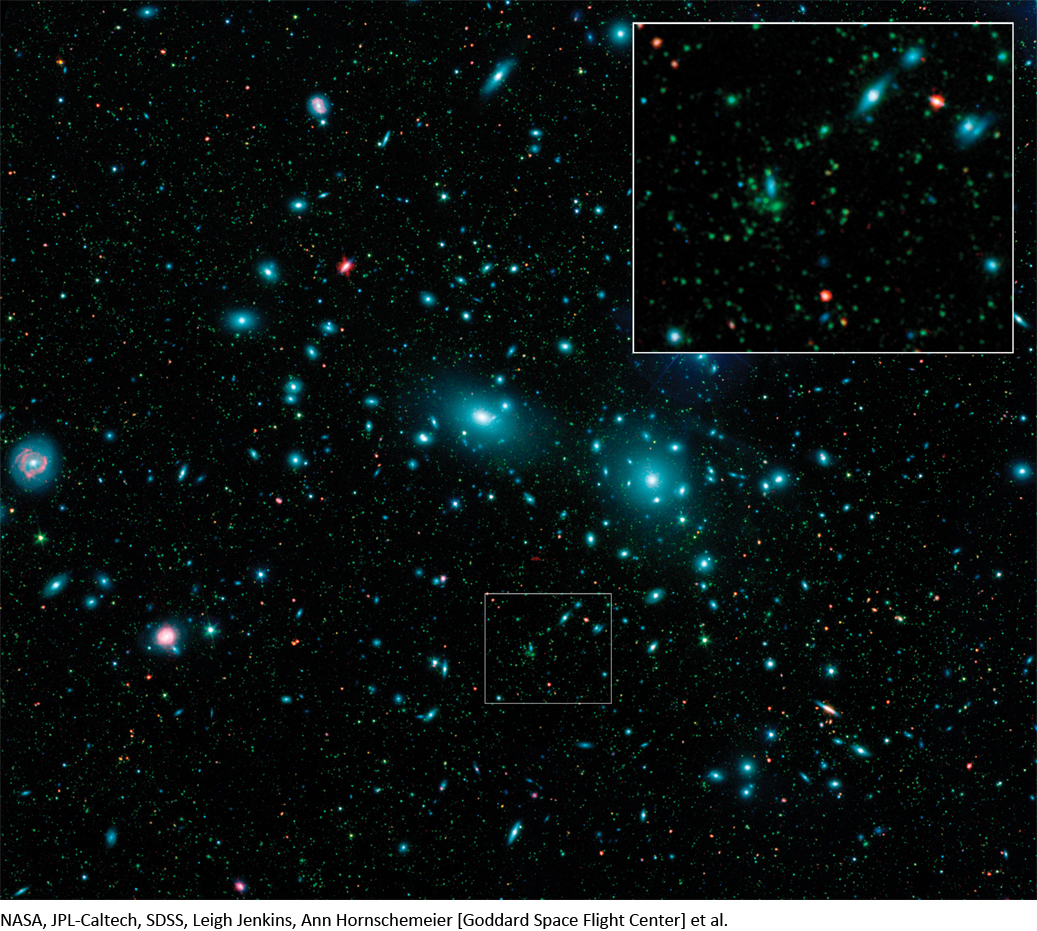
Question
ConceptCheck 14-9: How would a photograph of a regular cluster’s appearance compare to that of an irregular cluster?
Superclusters and Voids: Clusters of Clusters of Galaxies
 Go to Video 14-4
Go to Video 14-4
Clusters of galaxies are themselves grouped together in huge associations called superclusters. A typical supercluster contains dozens of individual clusters spread over a region of space up to 150 million ly across. Figure 14-18 shows the distribution of clusters in our part of the universe. The nearer ones out to the Virgo cluster, including our own Local Group, are members of the Local Supercluster. The other clusters shown in Figure 14-18 belong to other superclusters. The most massive cluster in the local universe is called the Great Attractor.
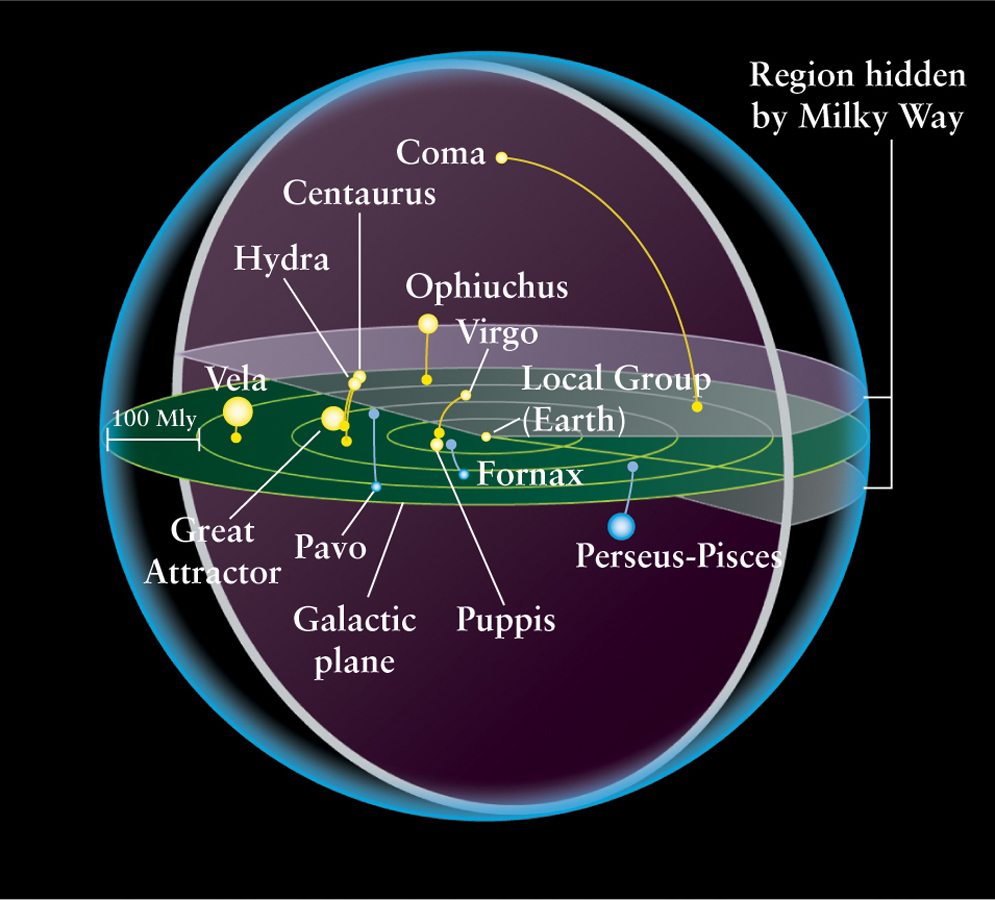
339
Observations indicate that, unlike clusters, superclusters are not bound together by gravity. That is, most clusters in each supercluster are drifting away from the other clusters in that same supercluster. Furthermore, the superclusters are all moving away from one another.
Since the 1980s, astronomers have been working to understand how superclusters are distributed in space. Some of this structure is revealed by maps such as Figure 14-19, which displays the positions on the sky of 1.6 million galaxies. Such maps reveal that superclusters are not randomly distributed, but seem to lie along filaments. But to comprehend more fully the distribution of superclusters, it is necessary to map their positions in three dimensions. This is done by measuring both the position of a galaxy on the sky as well as the galaxy’s distance and thus its position in three-dimensional space.
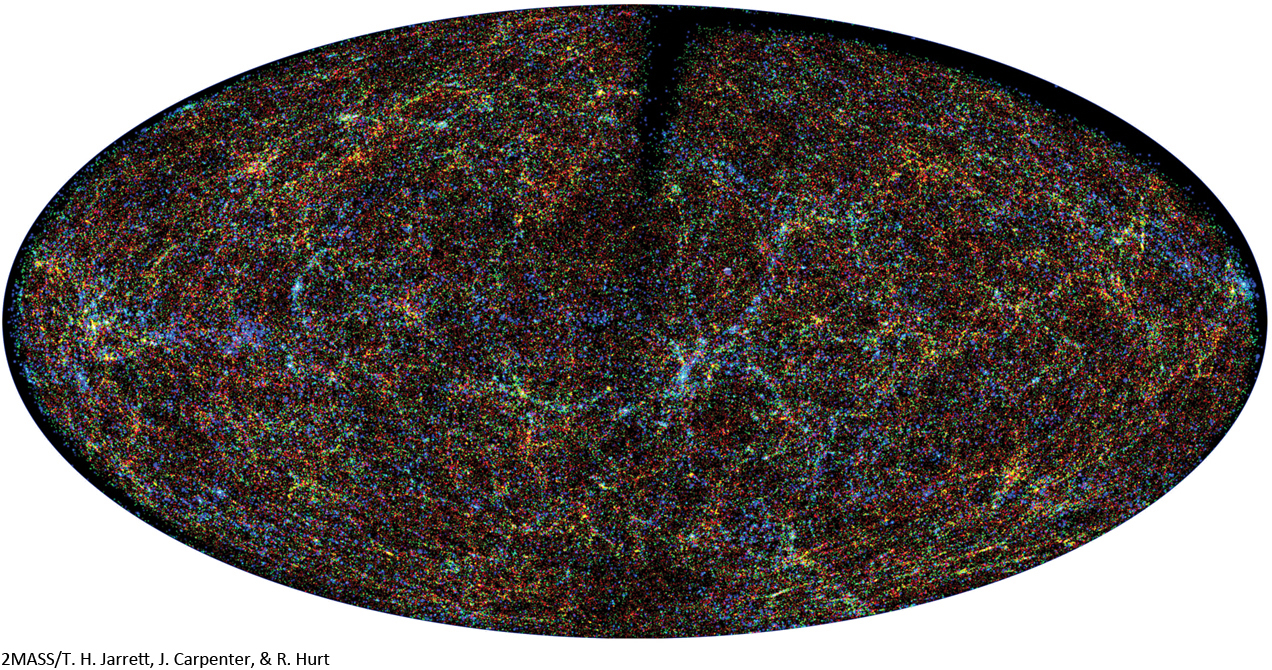
The most extensive galaxy maps available at this writing are those from the Sloan Digital Sky Survey, a joint project of astronomers from the United States, Japan, and Germany, and from the Two Degree Field Galactic Redshift Survey (2dFGRS), a collaboration between Australian, British, and U.S. astronomers. (The name refers to the 2° field of view of the telescope used for the observations, which is unusually wide for a research telescope.) Figure 14-20a shows a map made from 2dFGRS measurements of more than 60,000 galaxies. This particular map encompasses two wedge-shaped slices of the universe, one on either side of the plane of the Milky Way (Figure 14-20b). Earth (in the Milky Way) is at the apex of the wedge-shaped map; each dot represents a galaxy and extends out to a distance of nearly 1000 Mpc, or 3 billion ly from Earth.
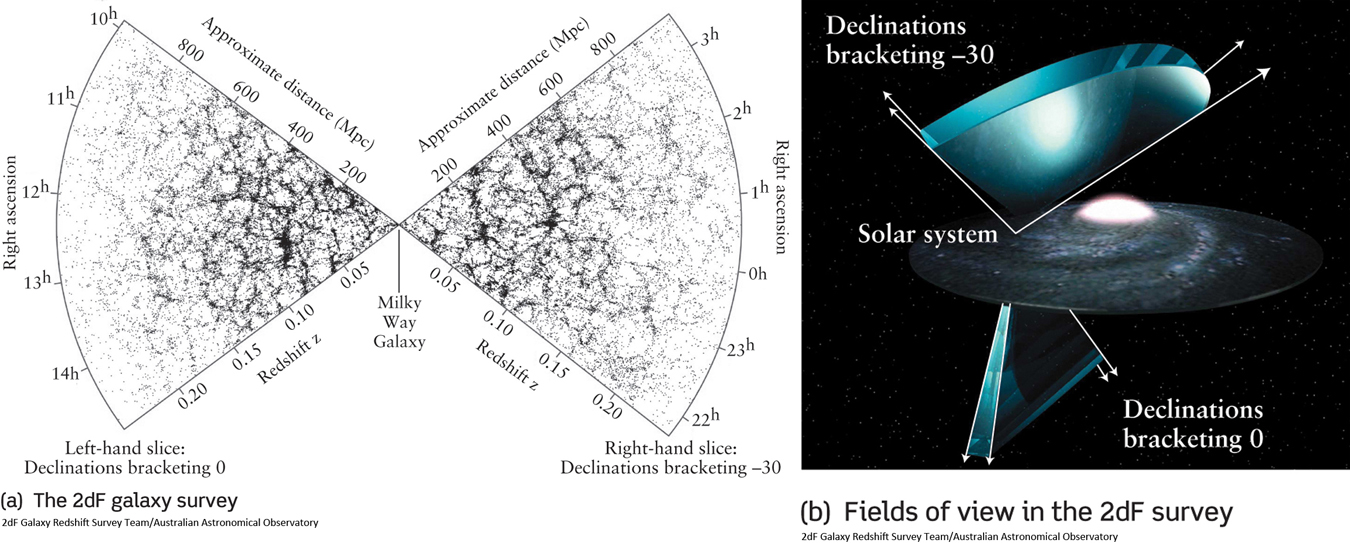
340
Maps such as that shown in Figure 14-20a reveal enormous voids where exceptionally few galaxies are found. These voids are roughly spherical and measure 100 million to 400 million ly in diameter. They are not entirely empty, however. There is evidence for hydrogen clouds in some voids, while others may be subdivided by strings of dim galaxies.
Figure 14-20a shows that most galaxies are concentrated in sheets on the surfaces between voids. This pattern is similar to that of soapsuds in a kitchen sink, with sheets of soap film (analogous to galaxies) surrounding air bubbles (analogous to voids). These titanic sheets of galaxies are the largest structures known in the universe: On scales much larger than 300 million ly, the distribution of galaxies in the universe appears to be roughly uniform.
Question
ConceptCheck 14-10: Are superclusters evenly distributed throughout the universe?
Question
ConceptCheck 14-11: What is the most common type of galaxy in our Local Group?